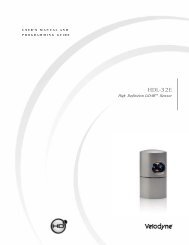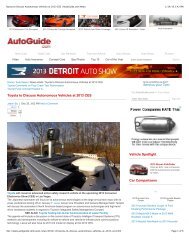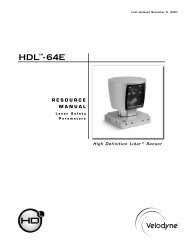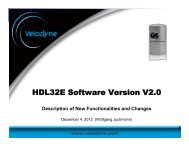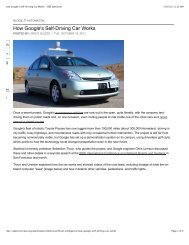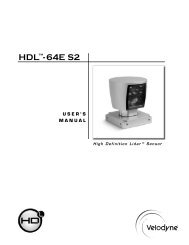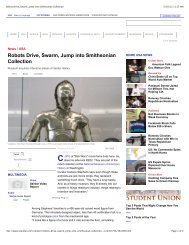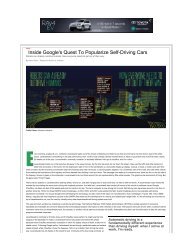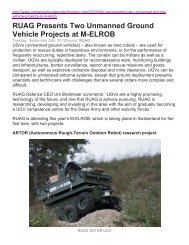On the Segmentation of 3D LIDAR Point Clouds - Velodyne Lidar
On the Segmentation of 3D LIDAR Point Clouds - Velodyne Lidar
On the Segmentation of 3D LIDAR Point Clouds - Velodyne Lidar
Create successful ePaper yourself
Turn your PDF publications into a flip-book with our unique Google optimized e-Paper software.
1<br />
0.95<br />
0.9<br />
0.95<br />
0.9<br />
0.89<br />
0.9<br />
0.85<br />
0.88<br />
X: 0.1716<br />
Y: 0.8891<br />
Mean Fraction Classified (%)<br />
0.85<br />
0.8<br />
0.75<br />
0.7<br />
0.65<br />
Mean <strong>Point</strong> Score (%)<br />
0.8<br />
0.75<br />
0.7<br />
0.65<br />
Mean <strong>Point</strong> Score (%)<br />
0.87<br />
0.86<br />
0.85<br />
0.84<br />
0.83<br />
0.6<br />
0.6<br />
0.82<br />
0.55<br />
0.55<br />
0.81<br />
0.5<br />
0.4 0.5 0.6 0.7 0.8 0.9 1<br />
Mean <strong>Point</strong> Score (%)<br />
0.5<br />
0 1 2 3 4 5 6<br />
Mean Time (s)<br />
0.8<br />
0.16 0.18 0.2 0.22 0.24 0.26<br />
Mean Time (s)<br />
(a)<br />
(b)<br />
(c)<br />
Fig. 8. The results <strong>of</strong> <strong>the</strong> GP-INSAC method from Algorithm 3 for different parameter choices, averaged over <strong>the</strong> four test <strong>Velodyne</strong> scans. The trade-<strong>of</strong>f<br />
between <strong>the</strong> percentage <strong>of</strong> points classified vs point score is shown in (a), which indicates a near complete and accurate classification is possible. In (b)<br />
<strong>the</strong> point score and processing time is compared. In (c), only <strong>the</strong> results with a point score > 0.8, a percent classified > 0.9 and processing time < 0.25s<br />
seconds are shown. The result from <strong>the</strong> optimal parameters is highlighted.<br />
Here it is integrated into to <strong>the</strong> segmentation process, while<br />
in [10] it is obtained from posterior classification . Also, <strong>the</strong><br />
reasoning in <strong>the</strong> mesh is used here for ground extraction only<br />
(in <strong>the</strong> function ExtractGround) while it generates <strong>the</strong><br />
segmentation <strong>of</strong> <strong>the</strong> entire <strong>3D</strong> space in [10]. Table II shows<br />
that <strong>the</strong> performance <strong>of</strong> <strong>the</strong> latter method is lower. As for <strong>the</strong><br />
o<strong>the</strong>r techniques, a range <strong>of</strong> parameter values was tested and<br />
results averaged over <strong>the</strong> four labeled scans. Following <strong>the</strong><br />
notations in [10], ɛ 1 was varied from 0 to 45 with a step size<br />
<strong>of</strong> 5, ɛ 2 was varied from 0 to 60 with a step size <strong>of</strong> 10, and<br />
ɛ 3 from 0 to 0.7 with a step size <strong>of</strong> 0.1. For both point and<br />
voxel scores, <strong>the</strong> optimal values were found to be 40 for ɛ 1 ,<br />
50 for ɛ 2 and 0.5 for ɛ 3 . The lower performance is in part due<br />
to <strong>the</strong> limited size <strong>of</strong> <strong>the</strong> labeled set and <strong>the</strong> behaviour <strong>of</strong> <strong>the</strong><br />
segmentation metric: for certain combinations <strong>of</strong> parameters,<br />
<strong>the</strong> segmentation is visually close to <strong>the</strong> one obtained with<br />
<strong>the</strong> mesh segmenter but <strong>the</strong> ground is divided into a few main<br />
parts which causes a large penalty, since <strong>the</strong> ground has a<br />
dominating weight in both <strong>the</strong> point and <strong>the</strong> voxel scores.<br />
VI. CONCLUSION<br />
This study has proposed a set <strong>of</strong> segmentation methods<br />
designed for various densities <strong>of</strong> <strong>3D</strong> point clouds. It first provided<br />
empirical evidence <strong>of</strong> <strong>the</strong> benefit <strong>of</strong> ground extraction<br />
prior to object segmentation in <strong>the</strong> context <strong>of</strong> dense data. The<br />
Cluster-All method has achieved <strong>the</strong> best trade <strong>of</strong>f in terms<br />
<strong>of</strong> simplicity, accuracy and computation times. Its limitations<br />
were shown in <strong>the</strong> context <strong>of</strong> sparse data and two novels<br />
segmentation techniques were proposed for <strong>the</strong> latter case:<br />
<strong>the</strong> GP-INSAC algorithm for probabilistic ground modeling<br />
and for <strong>the</strong> processing <strong>of</strong> any <strong>3D</strong> point cloud sparse or dense,<br />
potentially formed <strong>of</strong> data accumulated from several sensors;<br />
a Mesh Based technique, optimised for <strong>the</strong> processing <strong>of</strong><br />
range images. All <strong>the</strong> algorithms were evaluated on several<br />
sets <strong>of</strong> hand labeled data using two novel metrics.<br />
REFERENCES<br />
[1] Y. Boykov and G. Funka-Lea. Graph cuts and efficient nd image<br />
segmentation. International Journal <strong>of</strong> Computer Vision, 70(2):109–<br />
131, 2006.<br />
[2] J. Diebel and S. Thrun. An application <strong>of</strong> markov random fields to<br />
range sensing. Advances in neural information processing systems,<br />
18:291, 2006.<br />
[3] B. Douillard, J. Underwood, N. Melkumyan, S. Singh, S. Vasudevan,<br />
C. Brunner, and A. Quadros. Hybrid elevation maps: 3d surface models<br />
for segmentation. In Proc. <strong>of</strong> <strong>the</strong> IEEE/RSJ International Conference<br />
on Intelligent Robots and Systems (IROS), 2010.<br />
[4] P.F. Felzenszwalb and D.P. Huttenlocher. Efficient graph-based image<br />
segmentation. International Journal <strong>of</strong> Computer Vision, 59(2):167–<br />
181, 2004.<br />
[5] Martin A. Fischler and Robert C. Bolles. Random sample consensus:<br />
a paradigm for model fitting with applications to image analysis and<br />
automated cartography. Commun. ACM, 24(6):381–395, 1981.<br />
[6] A. Golovinskiy and T. Funkhouser. Min-cut based segmentation <strong>of</strong><br />
point clouds. princeton University.<br />
[7] A. Hoover, G. Jean-Baptiste, X. Jiang, P.J. Flynn, H. Bunke, D.B.<br />
Goldg<strong>of</strong>, K. Bowyer, D.W. Eggert, A. Fitzgibbon, and R.B. Fisher.<br />
An experimental comparison <strong>of</strong> range image segmentation algorithms.<br />
IEEE transactions on pattern analysis and machine intelligence,<br />
18(7):673–689, 1996.<br />
[8] T. Malisiewicz and A. Efros. Improving spatial support for objects via<br />
multiple segmentations. In British Machine Vision Conference, pages<br />
282–289, 2007.<br />
[9] N. Melkumyan. Surface-based Syn<strong>the</strong>sis <strong>of</strong> <strong>3D</strong> Maps for outdoor Unstructured<br />
Environments. PhD <strong>the</strong>sis, University <strong>of</strong> Sydney, Australian<br />
Centre for Field Robotics, 2008.<br />
[10] F. Moosmann, O. Pink, and C. Stiller. <strong>Segmentation</strong> <strong>of</strong> <strong>3D</strong> <strong>Lidar</strong> Data<br />
in non-flat Urban Environments using a Local Convexity Criterion. In<br />
IEEE Intelligent Vehicles Symposium, pages 215–220, 2009.<br />
[11] F. Pauling, M. Bosse, and R. Zlot. Automatic <strong>Segmentation</strong> <strong>of</strong> <strong>3D</strong><br />
Laser <strong>Point</strong> <strong>Clouds</strong> by Ellipsoidal Region Growing. In Proc. <strong>of</strong> <strong>the</strong><br />
Australasian Conference on Robotics & Automation (ACRA), 2009.<br />
[12] Rahul Raguram, Jan-Michael Frahm, and Marc Pollefeys. A comparative<br />
analysis <strong>of</strong> ransac techniques leading to adaptive real-time<br />
random sample consensus. In David Forsyth, Philip Torr, and Andrew<br />
Zisserman, editors, Computer Vision ECCV 2008, volume 5303 <strong>of</strong><br />
Lecture Notes in Computer Science, pages 500–513. Springer Berlin<br />
/ Heidelberg, 2008.<br />
[13] J. Schoenberg, A. Nathan, and M. Campbell. <strong>Segmentation</strong> <strong>of</strong> dense<br />
range information in complex urban scenes. In Proc. <strong>of</strong> <strong>the</strong> IEEE/RSJ<br />
International Conference on Intelligent Robots and Systems (IROS),<br />
2010. To appear.<br />
[14] J. Shi and J. Malik. Normalized cuts and image segmentation. IEEE<br />
Transactions on pattern analysis and machine intelligence, 22(8):888–<br />
905, 2000.<br />
[15] B. Siciliano and O. Khatib. Springer handbook <strong>of</strong> robotics. Springer,<br />
2008.<br />
[16] J. Strom, A. Richardson, and E. Olson. Graph-based segmentation <strong>of</strong><br />
colored 3d laser point clouds. In Proc. <strong>of</strong> <strong>the</strong> IEEE/RSJ International<br />
Conference on Intelligent Robots and Systems (IROS), 2010. To appear.<br />
[17] R. Triebel, J. Shin, and R. Siegwart. <strong>Segmentation</strong> and unsupervised<br />
part-based discovery <strong>of</strong> repetitive objects. In Proceedings <strong>of</strong> Robotics:<br />
Science and Systems, Zaragoza, Spain, June 2010.<br />
[18] S. Vasudevan, F. Ramos, E Nettleton, and H. Durrant-Whyte. Gaussian<br />
process modeling <strong>of</strong> large-scale terrain. Journal <strong>of</strong> Field Robotics,<br />
26:812840, 2009.<br />
[19] Z. Wu and R. Leahy. An optimal graph <strong>the</strong>oretic approach to<br />
data clustering: Theory and its application to image segmentation.<br />
IEEE transactions on pattern analysis and machine intelligence, pages<br />
1101–1113, 1993.<br />
[20] X. Zhu, H. Zhao, Y. Liu, Y. Zhao, and H. Zha. <strong>Segmentation</strong> and<br />
classification <strong>of</strong> range image from an intelligent vehicle in urban<br />
environment. In Proc. <strong>of</strong> <strong>the</strong> IEEE/RSJ International Conference on<br />
Intelligent Robots and Systems (IROS), 2010. To appear.




